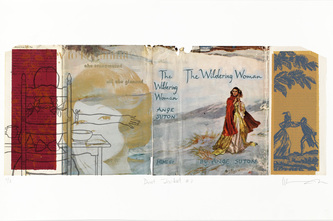Covering the Story
A box of discarded romance novels from the 40s and 50s discovered by chance became the basis for this series. Cunningham was particularly drawn to the graphic design of the dust jackets protecting the books. A dust jacket is designed to be seen as a three-dimensional object but only one side can be seen at a time. When a dust jacket is unfolded and laid out flat; spine, front cover, back cover and flaps are all forced onto one plane. Then, the text and images interact with each other in a way they were never intended to, telling a different story. Scanning and digitally printing the dust jackets on archival paper Cunningham sought to deepen the narratives by screenprinting additional images, texts and textures over top. This camouflage disrupts the fictive reading, requiring the viewer to weave together his or her own story.
A box of discarded romance novels from the 40s and 50s discovered by chance became the basis for this series. Cunningham was particularly drawn to the graphic design of the dust jackets protecting the books. A dust jacket is designed to be seen as a three-dimensional object but only one side can be seen at a time. When a dust jacket is unfolded and laid out flat; spine, front cover, back cover and flaps are all forced onto one plane. Then, the text and images interact with each other in a way they were never intended to, telling a different story. Scanning and digitally printing the dust jackets on archival paper Cunningham sought to deepen the narratives by screenprinting additional images, texts and textures over top. This camouflage disrupts the fictive reading, requiring the viewer to weave together his or her own story.




